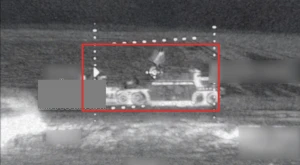
Russia has deployed 30% of its Nona-S systems in combat, but has almost 300 more in reserve
The number of Russian Nona-S systems currently deployed at various storage bases affects Russia's ability to wage war against Ukraine
This is reported by Defense Express.
According to the Ukrainian General Staff, since February 2022, the Russian army has lost more than 7,000 of its artillery systems on the battlefield, and to replenish its losses, the enemy is forced to tap into its stocks, which it has at various storage bases.
An interesting analysis in this context is that of an OSINT researcher who publishes his posts on social network X under the handle @HighMarsed - based on satellite images, he calculated how many 2C9 Nona-S self-propelled universal artillery systems the Russian troops had at their storage bases and how many of them have already been decommissioned by the invading forces.
<blockquote class="twitter-tweet"><p lang="en" dir="ltr">How many 2S9 does Russia have in storage? MB2022 claims 500 were in storage and I found 416 of them before the war. It is possible that the remaining 84 were stored inside garages. In more recent footage I found that 130 (~31%) have already been removed since the war started. <a href="https://t.co/qrsiVgJTER">pic.twitter.com/qrsiVgJTER</a></p>— high_marsed (@HighMarsed) <a href="https://twitter.com/HighMarsed/status/1715028654739075077?ref_src=twsrc%5Etfw">October 19, 2023</a></blockquote> <script async src="https://platform.twitter.com/widgets.js" charset="utf-8"></script>
Thus, in total, as of 2021, Russia had 416 Nona-S systems in storage, while in 2023 this number dropped to 286, meaning that in about two years the invading forces had brought in 130 of these systems, or 31.25% of all the systems they had in storage.
For example, as of May 2021, the Russian forces had 156 Nona-S systems, while in June 2023, they had 95 (minus 61 vehicles). As of October 2021, there were 176 vehicles, and in August 2023 - 124 (minus 52 vehicles). At the 7020th storage base, the number of systems from 42 units in September 2021 decreased to 25 (minus 17 vehicles).
An important nuance that the author emphasizes is that according to Military Balance, as of 2022, the Russian forces had 500 units of 2C9 Nona-S at their storage bases, and therefore another 84 vehicles may well be "hiding" somewhere "under the roof," but we should not rule out the possibility that the guide provides approximate figures for equipment at storage bases, which were simply "rounded up."
<blockquote class="twitter-tweet"><p lang="en" dir="ltr"><a href="https://twitter.com/hashtag/Ukraine?src=hash&ref_src=twsrc%5Etfw">#Ukraine</a>: A Russian 2S9 Nona-S 120mm self-propelled mortar was destroyed by a FPV loitering munition of the Ukrainian 72nd Mechanized Brigade in <a href="https://twitter.com/hashtag/Donetsk?src=hash&ref_src=twsrc%5Etfw">#Donetsk</a> Oblast. <br><br>Again, we can see a powerful ammo detonation, common with this type of vehicle. <a href="https://t.co/ujAcmTSrrY">pic.twitter.com/ujAcmTSrrY</a></p>— ???????? Ukraine Weapons Tracker (@UAWeapons) <a href="https://twitter.com/UAWeapons/status/1705852827233300773?ref_src=twsrc%5Etfw">September 24, 2023</a></blockquote> <script async src="https://platform.twitter.com/widgets.js" charset="utf-8"></script>
"As for the number of these vehicles in the armed forces, Military Balance cites the following data: the Russian Airborne Forces have the most vehicles, 250 units of various modifications in total, the Marines have 30 vehicles, and open sources also indicate that the FSB Border Service had a certain number of such vehicles," Defense Express writes.
And according to Oryx, since February 2022, the Russian forces have lost at least 42 units of 2S9 Nona self-propelled artillery systems on the battlefield, most of them either destroyed or damaged, while only two vehicles were recorded as damaged.
Territorial defense fighters hunt for enemy's Nona
<iframe src="https://www.facebook.com/plugins/video.php?height=308&href=https%3A%2F%2Fwww.facebook.com%2F128obtro%2Fvideos%2F167664815809915%2F&show_text=false&width=560&t=0" width="560" height="308" style="border:none;overflow:hidden" scrolling="no" frameborder="0" allowfullscreen="true" allow="autoplay; clipboard-write; encrypted-media; picture-in-picture; web-share" allowFullScreen="true"></iframe>
At the same time, given the number of vehicles at storage bases, Russia still has a sufficient supply of weapons that can be restored to equip certain units or used as spare parts donors to repair vehicles damaged in combat. According to the forecasts of the head of the Main Intelligence Directorate, Kyrylo Budanov, in terms of weapons and military equipment, Russia will be able to fight until 2026, but given the losses and slow recovery rates, this date may eventually shift slightly to the left.
- News














































